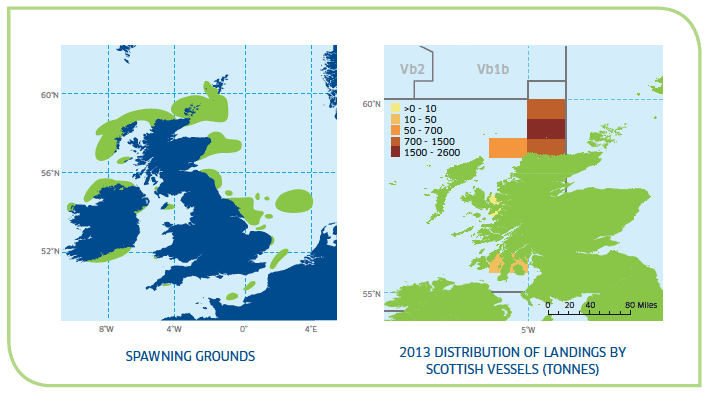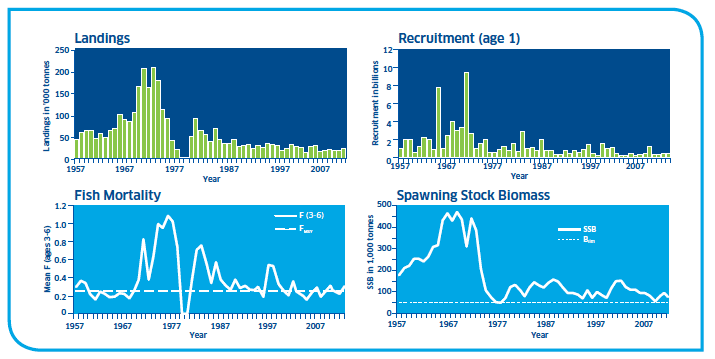Fish and Shellfish Stocks: 2015 Edition
Information on the state of fish and shellfish stocks of commercial importance to the Scottish fleet, inclduing Total Allowable Catches (TACs) for each stock.
Herring Stocks - West of Scotland (Vb, VIa north and VIb)
West coast herring ( Clupea harengus) is mainly prosecuted by large pelagic trawlers to the north and north-west of Scotland, with some small landings being taken in the Clyde by pair trawlers. Very little bycatch of other fish occurs within this fishery.
2015 position: UK share 13,711 tonnes [ 1]
Last Year: 16,959 tonnes [ 2]
Landed into Scotland in 2013: 10,233 tonnes [ 3]
Value for 2013: £3.5 million
Biology
Herring is widely distributed throughout the north- east Atlantic, ranging from the Arctic Ocean in the north to the English Channel in the south. During daytime, the shoals remain close to the sea bottom or in deep water but at dusk they move towards the surface and disperse over a wide area. Off the west of Scotland, the herring stock is composed of two groups of fish - one spawning in spring and the other in autumn. The majority of the population is made up of the latter group. Some herring are mature and able to spawn at two years old but most herring reach maturity by around four years. Autumn spawning takes place from late August until October, to the west and north of the Outer Hebrides and off Cape Wrath, in depths of up to 100m. Herring are demersal spawners, depositing their sticky eggs on coarse sand, gravel, small stones and rock. The shoals of herring gather on the spawning grounds and spawn more or less simultaneously. Each female releases her eggs in a single batch and the resulting egg carpet may be several layers thick and cover a considerable area. The eggs take about three weeks to hatch depending on the sea temperature; the warmer the water, the shorter the period of incubation. The newly hatched larvae follow the current systems and drift to the north and east. Some are retained on the west of Scotland but a large proportion are carried through the Fair Isle channel and travel well into the North Sea. In spring the larvae reach the nursery areas where they develop into juveniles. Young herring spend some time in the inshore areas and sea lochs before migrating offshore to join the adult population. There is some evidence from tagging experiments and from using biological markers to suggest that, as herring mature, some of those that moved as juveniles to the the east coast population make the return journey back to the west of Scotland spawning areas.
Herring feed mainly on crustaceans (shrimps and copepods) and young sandeels. There are no marked differences between the diets of large and small herring, only the proportions of different food items change with size.

ICES Advice on Management
Information Source: ICES advice 2014
http://www.ices.dk/sites/pub/Publication%20Reports/Advice/2014/2014/her-vian.pdf
Quoted text in italics.

MSY and precautionary approach reference points
| Type |
Value |
||
|---|---|---|---|
| Management Plan |
SSB MGT |
Not defined |
|
| F MGT |
SSB ≥ 75 kt |
F3-6 = 0.25 |
|
| SSB < 75 kt & ≥ 50 kt |
F3-6 = 0.20 |
||
| SSB < 50 kt |
F3-6 = 0.00 |
||
| MSY Approach |
MSY Btrigger |
Not defined |
|
| F MSY |
0.25 |
||
| Precautionary Approach |
Blim |
50,000 t |
|
| Bpa |
Not defined |
||
| Flim |
Not defined |
||
| Fpa |
Not defined |
||
State of stock and advice
- Fishing mortality for 2013 was estimated to be 0.268: this means that approximately 23.51%, by number, of all fish aged between 3 and 6 years were caught.
- The spawning stock biomass for 2014 was predicted to be around 80,836 tonnes. This is above the precautionary approach reference limit ( Blim).
- Fishing mortality cannot be determined
- in relation to the precautionary approach. The spawning stock biomass is above the precautionary limit. However, it cannot be determined in relation to any of the other reference points. Fishing mortality is above the level which is consistent with achieving maximum sustainable yield ( F2011< F MSY).
- The advice is in accordance with the management plan which recommends that the TAC for 2015 should be set at 22,690 tonnes.
The stock identity of herring to the west of the British Isles was reviewed by the EU-funded project WESTHER. This identified Division VIa (N) as an area where catches comprise a mixture of fish from Divisions VIa (N), VIa (S), and VIIa (N). In 2008, ICES convened the study group SGHERWAY to evaluate management for herring in these areas. In 2010, SGHERWAY concluded that, where single species/stock approaches give a distorted view on individual populations and catch characteristics do not reflect population dynamics, there is a need for metapopulation management. It also determined that managing the VIaN and VIaS/VIIb,c ICES stocks sustainably under different mixing scenarios and misidentification levels is possible but only with detailed information on fisheries independent data. These data are now being collected. However, it will be a number of years before ICES can provide a fully operational integrated strategy for these units. In this context HAWG recommends that the management plan for Division VIa (N) should be continued.
ICES advises that activities that have a negative impact on the spawning habitat of herring, such as extraction of marine aggregates and marine construction on the spawning grounds, should not occur.
Management outcomes for 2015
In December 2014 the Council of Ministers decided that the 2015 Total Allowable Catch for west of Scotland (Vb, VIa North and VIb) herring should be 22,690 tonnes. The 2015 UK quota has been set at 13,711 tonnes.
This quota decision was in line with scientific advice and results in a decrease in fishing opportunity.
Contact
There is a problem
Thanks for your feedback